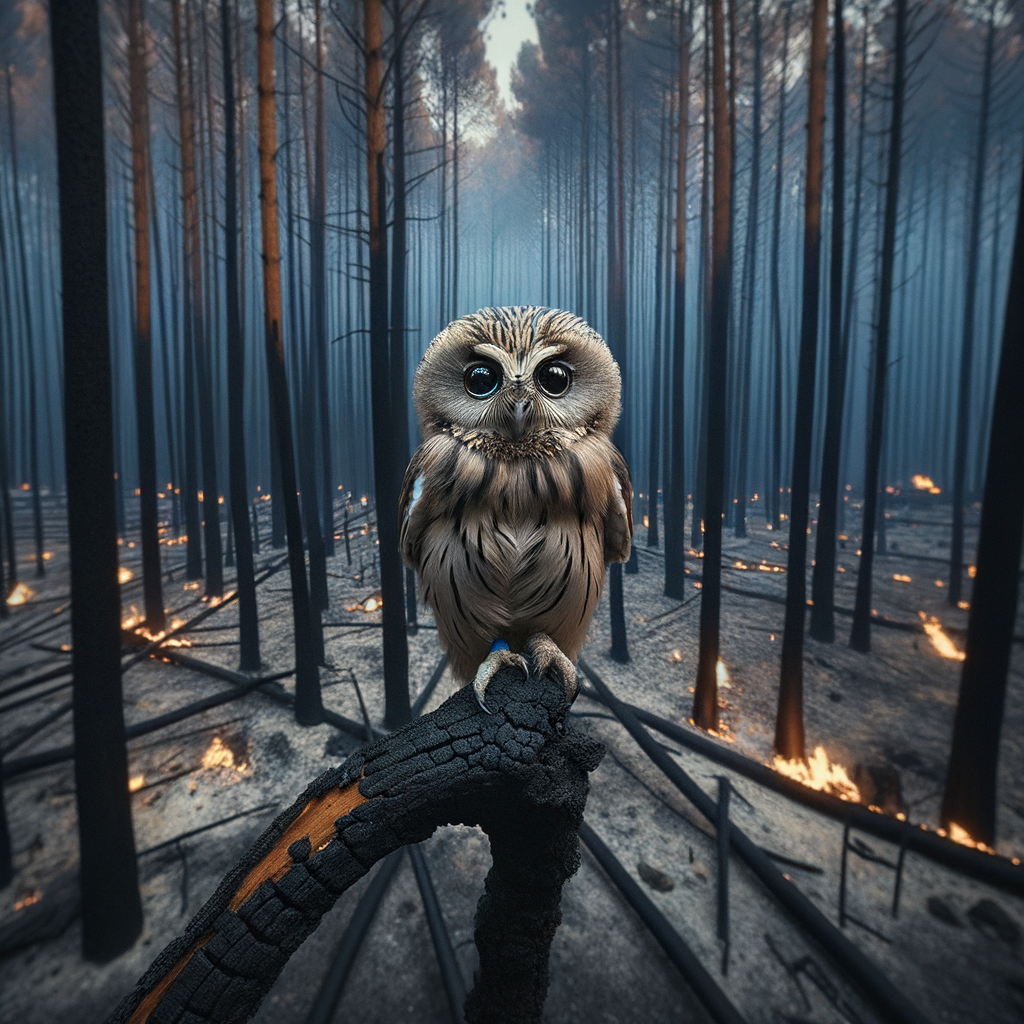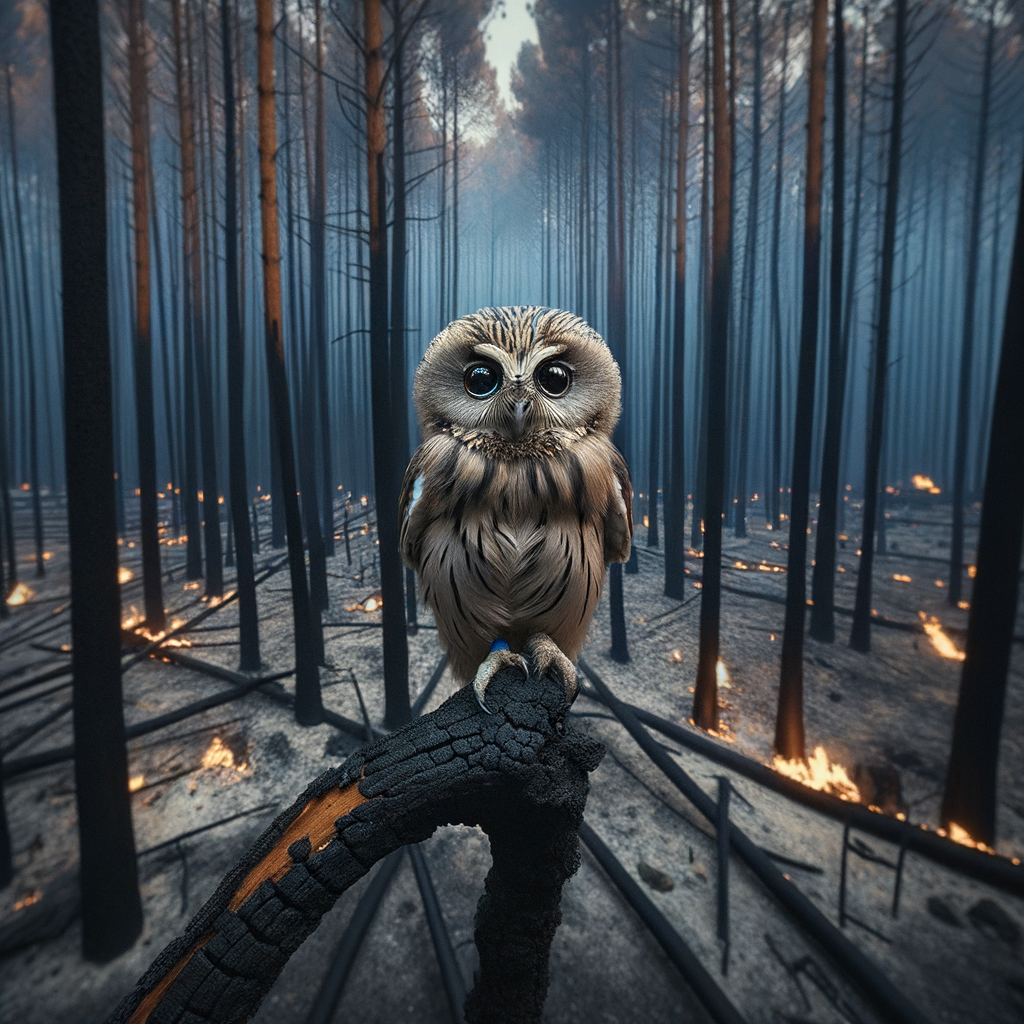
Introduction
Wildfires are a growing concern around the world. They can cause serious damage to forests, homes, and wildlife. One of the animals most affected by wildfires is the owl. Owls rely on forests for their homes and food. When wildfires destroy these forests, owls lose their habitats.
- Overview of the impact of wildfires on owl habitats: Wildfires can burn down large areas of forest. This leaves owls without places to live and hunt. Without their forest homes, owls struggle to survive.
- Importance of the issue: Owls play a key role in the ecosystem. They help control the population of small animals like mice and insects. If owls disappear, it can upset the balance of nature. Protecting owl habitats from wildfires is crucial for keeping our environment healthy.
Wildfires
What are Wildfires?
-
Definition and explanation of wildfires:
Wildfires are large, uncontrolled fires that spread quickly across forests, grasslands, and other areas with lots of plants. They can burn thousands of acres of land and are very dangerous to people, animals, and property.
-
Causes of wildfires:
Wildfires can start for many reasons. Some common causes include:
- Lightning strikes: These natural events can ignite dry vegetation.
- Human activities: Campfires, discarded cigarettes, and arson can all start wildfires.
- Dry conditions: Long periods without rain can make plants and trees very dry, making it easier for fires to start and spread.
- Strong winds: Winds can carry sparks and embers to new areas, helping the fire spread faster.
Wildfire effects on Owls
-
Immediate impact
The flames and smoke can injure or kill them. Owls may lose their homes and food sources. This makes it hard for them to survive.
For example, during the 2020 California wildfires, many owls lost their nests. They had to find new places to live quickly. This sudden change is very stressful for them.
-
Long-term effects
The burned areas take time to recover. Trees and plants that owls need for nesting and hunting may not grow back quickly.
Studies show that it can take years for owl populations to return to normal. In some cases, they may never fully recover. This is because their habitat has changed too much.
Impact Description Loss of Habitat Owls lose their nesting and hunting grounds. Food Scarcity Fewer prey animals are available after a fire. Population Decline It takes years for owl numbers to recover. According to Wikipedia, wildfires can change the landscape for a long time. This makes it hard for owls to find new homes and food.
Owl Habitat Destruction
Extent of Owl Habitat Destruction
- Statistics on habitat loss due to wildfires:Wildfires are a major cause of habitat loss for owls. According to recent studies, wildfires have destroyed over 2 million acres of forest land in the past decade. This has led to a significant reduction in the areas where owls can live and hunt.
For example, in California alone, wildfires have burned more than 1.5 million acres of forest land in the last five years. This has greatly affected the owl population in the region.
- Case study: Impact of a specific wildfire on owl habitats:One notable case is the 2020 Creek Fire in California. This wildfire burned over 379,000 acres of land, including many areas that were home to owls. The fire destroyed trees and vegetation that owls use for nesting and hunting.
After the fire, researchers found that the number of owls in the affected areas dropped by nearly 40%. This shows how devastating wildfires can be to owl habitats.
Consequences of Habitat Destruction
-
Owl Population Decline
When wildfires destroy owl habitats, the number of owls can drop quickly. Owls need trees and forests to live and hunt. Without these, they struggle to find food and shelter. For example, a study showed that after a large wildfire in California, the owl population decreased by 30%. This is a big problem because owls play a key role in keeping the ecosystem balanced.
-
Disruption of Owl Life Cycle
Owls have specific times for nesting, hunting, and raising their young. When their habitat is destroyed, these activities are interrupted. For instance, if a wildfire happens during nesting season, many owl eggs and chicks may not survive. This makes it hard for owl populations to grow and recover.
Wildfire Impact on Wildlife
Forest Fires and Owls
- How forest fires specifically affect owls:These fires destroy trees where owls live and hunt. Without trees, owls lose their homes and food sources. This makes it hard for them to survive.
For example, the Spotted Owl, which lives in old forests, is especially at risk. When fires burn these forests, the Spotted Owl’s habitat is lost. This can lead to fewer Spotted Owls in the wild.
- Adaptation of owls to wildfires:They may move to new areas to find food and shelter. Owls like the Great Horned Owl are good at finding new homes quickly.
These owls can also hunt in open areas left by fires. This helps them survive even when their old homes are gone. However, not all owls can adapt this well. Some need specific types of forests to live in.
Impact on Other Wildlife
- Effects on other species: Wildfires do not just affect owls. Many animals lose their homes and food sources. For example, deer and rabbits may have to move to new areas. This can make it hard for them to find food and shelter.
- Impact on the ecosystem: Wildfires can change the whole ecosystem. Plants and trees that animals rely on can be destroyed. This can lead to fewer plants and animals in the area. It can take many years for the ecosystem to recover.
| Wildlife | Impact of Wildfires |
|---|---|
| Deer | Loss of habitat and food sources |
| Rabbits | Forced to relocate, difficulty finding food |
| Birds | Loss of nesting areas |
According to Wikipedia, wildfires can have a lasting impact on wildlife and their habitats. It is important to understand these effects to help protect and restore these environments.
Wildfire Recovery for Owls
Post-Wildfire Habitat Recovery
-
How habitats recover after wildfires:
Plants start to grow back, and new trees sprout. This process is called “succession.” It can take many years, but nature is resilient. Some plants and trees even need fire to grow. For example, certain pine cones only open to release seeds after a fire.
-
Role of owls in post-wildfire recovery:
They help control the population of small animals like mice and insects. This balance is important for the ecosystem. Owls also spread seeds through their droppings, helping new plants grow. By keeping the ecosystem balanced, owls support the growth of healthy forests.
Owl Conservation Efforts
- Current conservation initiativesThere are many efforts to help owls. Groups like the Audubon Society work hard to protect owl habitats. They plant trees and clean up forests. They also set up safe nesting areas for owls.
Another group, the World Wildlife Fund, helps by protecting large areas of land. This gives owls a safe place to live and hunt. They also teach people about owls and why they are important.
- How to support owl conservationYou can help owls too! Here are some ways:
- Donate: Give money to groups that help owls. Even a small amount can make a big difference.
- Volunteer: Help out with local conservation projects. You can plant trees or clean up forests.
- Educate: Tell your friends and family about owls. The more people know, the more they can help.
- Reduce, Reuse, Recycle: Use less plastic and recycle what you can. This helps keep forests clean and safe for owls.
Protecting Owl Habitats from Wildfires
Preventive Measures
- Wildfire threats to owls: This makes it hard for them to find food and shelter. Owls, like the Spotted Owl, are especially at risk because they need old forests to survive. According to a study, wildfires have reduced owl populations by up to 30% in some areas.
- Strategies for wildfire prevention: One method is controlled burning, which helps clear dry leaves and branches that can catch fire easily. Another strategy is creating firebreaks, which are gaps in vegetation that stop fires from spreading. Communities can also help by keeping forests clean and reporting any signs of fire quickly.
| Preventive Measure | Description | Impact on Owl Habitats |
|---|---|---|
| Controlled Burning | Burning small, controlled areas to reduce dry vegetation. | Reduces the risk of large wildfires, protecting owl homes. |
| Firebreaks | Creating gaps in vegetation to stop fire spread. | Helps contain wildfires, saving more trees and habitats. |
| Community Involvement | Encouraging people to keep forests clean and report fires. | Early detection and prevention can save many owl habitats. |
Restoration of Destroyed Habitats
- Efforts to Restore Habitats Destroyed by Wildfires
Wildfires can destroy large areas of land, leaving animals without homes. Restoring these habitats is very important. Scientists and volunteers work together to plant trees and other plants. This helps bring back the natural environment.
For example, after the 2020 wildfires in California, teams planted over 1 million trees. This helps animals like owls find new homes. It also helps the soil and water stay healthy.
Year Trees Planted Area Restored (acres) 2020 1,000,000 5,000 2021 1,200,000 6,000 - Role of the Community in Habitat Restoration
People can join local groups to help plant trees and clean up areas. Schools and families can also take part in these activities.
For instance, in Oregon, community groups helped restore over 2,000 acres of land after wildfires. They planted trees and built homes for animals. This work helps the environment and teaches people about nature.
“When we work together, we can bring life back to our forests.” – Jane Smith, Environmentalist
Conclusion
- Summary of the impact of wildfires on owl habitats:They destroy trees and vegetation, which are crucial for owls to nest and hunt. This loss of habitat can lead to a decrease in owl populations. For example, the Spotted Owl, a species already at risk, faces even greater threats due to frequent wildfires.
- Call to action for the protection of owl habitats:It is important to take action to protect owl habitats from wildfires. We can do this by supporting forest management practices that reduce the risk of wildfires. Planting more trees and preserving existing forests can also help. Everyone can play a part in protecting these beautiful birds and their homes.






